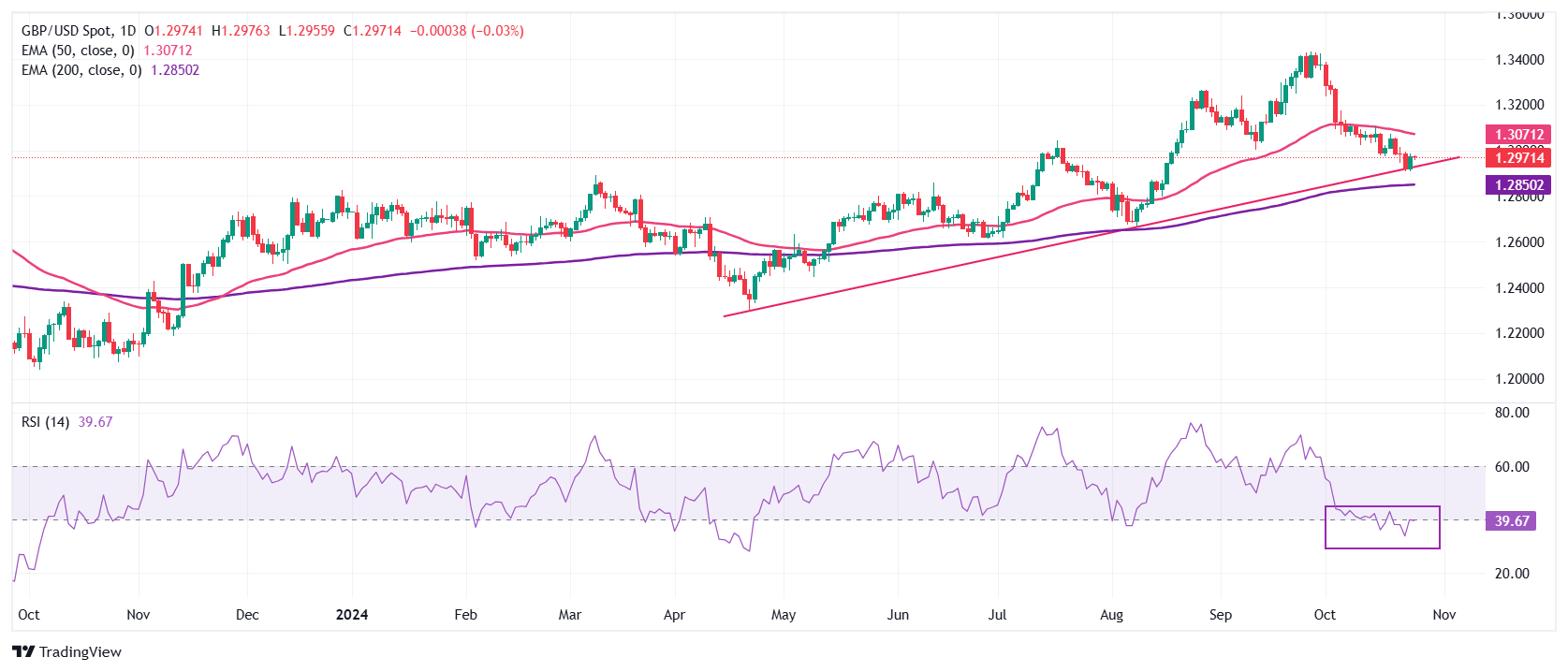Pound Sterling gains further on BoE Mann’s hawkish remarks

- The Pound Sterling consolidates after recovering slightly on Thursday as BoE’s Mann said services inflation needs to decline further for more rate cuts.
- The UK flash PMI report shows that business activity continued to expand in October but at a slower pace.
- Traders seem to be increasingly betting that Donald Trump will win the US presidential election.
The Pound Sterling (GBP) rises further near the psychological resistance of 1.3000 against the US Dollar (USD) in Friday’s New York session. The GBP/USD pair gains as the US Dollar extends its correction after the release of the United States (US) Durable Goods Orders data for September. The US Dollar Index (DXY), which gauges Greenback’s value against six major currencies, tests territory below 104.00. New orders for core goods contracted at a steady pace of 0.8% in September, however, the pace of decline was slower than expectations of 1.0%, pointing to a steady market for durable goods.
Broadly, the outlook of the US Dollar remains positive as traders price in former President US Donald Trump’s victory ahead of the presidential election on November 5, a scenario that traders think is a positive for the US Dollar. Market participants are expected to see higher tariffs and lower taxes in case of a Trump administration, which could negatively impact currencies from trading partners. However, the US Dollar could witness a sharp repricing if current Vice President Kamala Harris wins the presidential elections, said Standard Chartered.
Meanwhile, firm speculation that the Federal Reserve (Fed) will pursue a gradual interest rate cut path could keep any correction in the US Dollar limited. According to the CME FedWatch tool, the Fed is expected to cut interest rates again in November and December but at a usual pace of 25 basis points (bps). In September, the Fed started its policy-easing cycle with a 50-bps interest rate cut.
On the economic front, investors will pay close attention to the , which will be published at 12:30 GMT. Economists expect new orders for durable goods to have declined by 1% after remaining flat in August.
Daily digest market movers: Pound Sterling outperforms its major peers
- The Pound Sterling holds onto Thursday’s recovery against its major peers on Friday, although it looks set to post its fourth consecutive week of losses against the US Dollar. Still, the near-term outlook of the British currency appears to have improved on multiple tailwinds: hawkish remarks from Bank of England (BoE) Monetary Policy Committee (MPC) member Catherine Mann, and a continuous expansion in economic activity signaled by the flash United Kingdom (UK) S&P Global/CIPS Purchasing Managers Index (PMI) data for October.
- In a panel discussion at the sidelines of International Monetary Fund (IMF) meetings, Catherine Mann – an outspoken hawk – welcomed the soft inflation figures for September but emphasized the need for more slowdown. Despite a decline in the service inflation below 5%, Mann said that inflation in the services sector still has a long way to go in order to be aligned with the bank’s target of 2%.
- When asked about her current stance on interest rates, Mann said: “It would be premature to cut rates if you have structural persistence in the relationship between wages and price formation.” Despite Mann’s hawkish comments, traders continue to bet that the BoE will reduce interest rates further in November.
- Meanwhile, Thursday’s preliminary PMI report showed that the UK’s business activity expanded in both the manufacturing and the service sectors, albeit at a slower pace compared with September. Even though the overall growth was slower than projected, it was still better than that reported in the United States (US) and the Eurozone, where output in the manufacturing sector continues to contract.
Technical Analysis: Pound Sterling aims to climb above 1.3000
The Pound Sterling rises to near 1.3000 against the US Dollar, holding onto Thursday’s rebound after discovering buying interest near the lower boundary of a Rising Channel chart formation around 1.2900 on the daily time frame.
The near-term trend of the Cable is still uncertain as it trades below the 50-day Exponential Moving Average (EMA) at around 1.3070.
The 14-day Relative Strength Index (RSI) remains below 40.00, signals an active bearish momentum.
Looking down, the 200-day EMA near 1.2845 will be a major support zone for Pound Sterling bulls. On the upside, the Cable will face resistance near the 20-day EMA around 1.3060.
